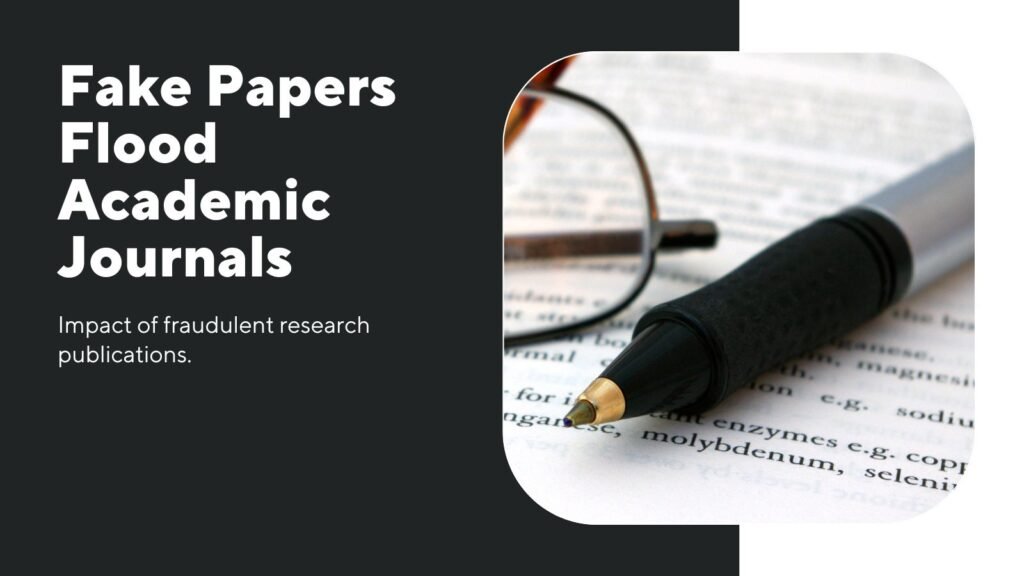The issue of fake scientific papers flooding academic journals has become a significant concern within the scientific community, with recent reports highlighting the scale and impact of this problem. The proliferation of fraudulent research is attributed to various factors, including the pressure on researchers to publish, the emergence of “paper mills” that produce fake studies for a fee, and the challenges faced by journals in detecting and preventing the publication of such papers.

The Scale of the Problem
Recent investigations have revealed that fake studies in academic journals may be more common than previously thought. A study led by neuropsychologist Bernhard Sabel estimated that up to 34% of neuroscience papers published in 2020 were likely made up or plagiarized, with a similar figure of 24% for medical papers[2][11].
This represents a significant increase from levels calculated for 2010 and suggests that journals are awash in a rising tide of manuscripts from paper mills[11]. In 2024 alone, the publisher Wiley announced the closure of 19 journals due to being infected by large-scale research fraud, highlighting the financial and reputational damage caused by fake papers[1].
The Role of Paper Mills
Paper mills are identified as one of the primary sources of fraudulent research. These entities, often based in countries like China, India, Iran, Russia, and some former Soviet Union states, generate fabricated work for submission to journals[12]. They offer services ranging from listing a scientist as an author of a wholly or partially fabricated paper to submitting the work to journals, often targeting publications such as one-off special editions that might not undergo as thorough a review[16]. The business model of paper mills relies on the desperation of researchers to publish, exploiting the academic pressure to produce scientific publications for career advancement[1][3].
Efforts to Combat the Issue
In response to the growing crisis, various stakeholders in the academic publishing industry are taking steps to combat the influx of fake papers. Wiley, for example, launched a paper mill detection tool after losing millions due to fraudulent journal submissions[13]. This tool is part of a broader effort by academic publishers to develop new methods for identifying and preventing the publication of fraudulent research[15]. Additionally, a high-profile group of funders, academic publishers, and research organizations has launched an initiative to tackle paper mills through measures such as improving author-verification methods[6].
The Impact on Scientific Integrity
The flood of fake scientific papers poses a significant threat to the integrity of research and the credibility of the scientific literature. Fraudulent studies can mislead readers, distort systematic reviews, and potentially influence medical care and policy decisions based on inaccurate data[2][12]. The situation has been described as a crisis point for research credibility, with experts warning of the long-term consequences of constructing careers on fraudulent science[12].
Conclusion
The challenge of fake scientific papers requires a multifaceted response, including better detection tools, stricter publication standards, and a shift in the academic culture that prioritizes quality over quantity in research output. As the scientific community grapples with this issue, it is clear that maintaining the integrity of scientific research is paramount for advancing knowledge and informing policy and practice based on reliable evidence.
Discover more AI news here.
Citations:
[1] https://mindmatters.ai/2024/05/can-ai-help-stem-the-tide-of-fake-science-papers/
[2] https://www.npr.org/2023/05/14/1176062276/fake-studies-in-academic-journals-may-be-more-common-than-previously-thought
[3] https://www.analystnews.org/posts/plagiarism-paper-mills-and-profit-these-scientists-are-fighting-the-epidemic-of-fraudulent-science-research
[4] https://www.semafor.com/article/05/10/2023/scientific-papers-fraudulent
[5] https://www.ncbi.nlm.nih.gov/pmc/articles/PMC3914431/
[6] https://www.infodocket.com/2024/01/20/report-sciences-fake-paper-problem-high-profile-effort-will-tackle-paper-mills/
[7] https://www.ncbi.nlm.nih.gov/pmc/articles/PMC9397156/
[8] https://en.wikipedia.org/wiki/List_of_scientific_misconduct_incidents
[9] https://gijn.org/stories/academic-research-fraud-errors/
[10] https://en.wikipedia.org/wiki/Grievance_studies_affair
[11] https://www.science.org/content/article/fake-scientific-papers-are-alarmingly-common
[12] https://www.theguardian.com/science/2024/feb/03/the-situation-has-become-appalling-fake-scientific-papers-push-research-credibility-to-crisis-point
[13] https://www.darkdaily.com/2024/05/06/wiley-launches-paper-mill-detection-tool-after-losing-millions-due-to-fraudulent-journal-submissions/
[14] https://www.sciencenews.org/article/fake-news-misinformation-covid-vaccines-conspiracy
[15] https://www.ft.com/content/1e49f64b-e8ab-48c0-8890-b33be56e5c31
[16] https://www.statnews.com/pharmalot/2024/05/15/psychedelics-fraud-research-novo-lilly-compounding-eisai-biogen-alzheimers-abbott-amgen-cancer-abbvie-dynavax-ascendis-hepatitis/
[17] https://www.economist.com/china/2024/02/22/why-fake-research-is-rampant-in-china
[18] https://en.wikipedia.org/wiki/Sokal_affair
[19] https://www.snexplores.org/article/how-to-resist-and-counter-todays-flood-of-fake-news
[20] https://www.mcgill.ca/oss/article/critical-thinking-general-science/science-journals-will-publish-anything






